In recent years growth hacking has taken the world by storm and the underlying principles can be found inside the roots a lot of companies, some of which are maybe unaware of our growth hacking vocabulary. We compiled a list of 11 interesting and diverse examples to show that true growth can be found in any of the seven pillars of growth hacking.
In our opinion, these are the eleven best examples of Dutch companies who established good growth through applying growth hacking principles:
Best Dutch Growth hacks
Booking.com
Let's start with Booking.com, a growth hacking case that could easily make our article on classic growth hacking examples. Did you know that similarly to giants like Facebook and Microsoft, they launch thousands of tests each day? Through this experimentation mindset, they have grown their market value to 100 billion in 2018. Not bad for a company which was established in 1996 by Dutch student - Geert-Jan Bruinsma.
As with many examples in this list, Booking.com did not grow by only one extremely impactful hack. They achieved their growth with a clear focus on the entire customer journey. They are constantly running experiments to see what will positively impact their growth.
One of Booking.com's key successes is that it has a huge focus on its customers' hopes, dreams, pains, and fears (also known as the Customer Desire Map). They successfully tested things like free cancellation, user reviews, and the infamous '5 people are viewing this room right now' hack.
Key takeaway: By adopting a true growth mindset, implementing the experimentation focus to every aspect of the business, and not listening to hippo's (highest paid person's opinion), they could grow to one of the leading internet companies.
Fun fact: Because only 10% of their experiments are a success, Booking.com created a ‘fail budget’ they use to cover for the effects of failed experiments. If there’s still room in the budget it is seen as an indication, they ran too many experiments in the comfort zone.
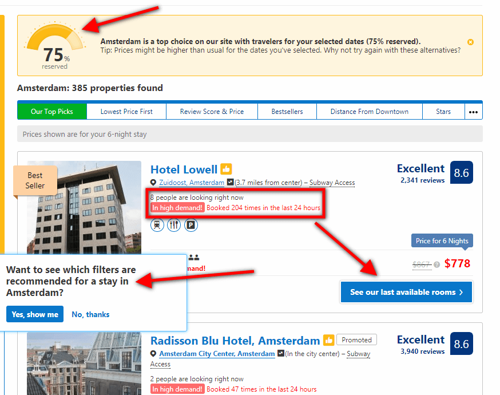
An example of how the scarcity principe of persuasion is used on Booking.com Source: OmniDigit
Charlie Temple
Why does a pair of glasses have to be so expensive? That’s exactly the question Charlie Temple founder Leon Planken asked himself when he went out to buy a pair of glasses for his son. After waiting for three weeks for a pair of glasses that cost €400,- he wasn’t able to answer that question.
Fastforward to 2020 and his company Charlie Temple was able to take a piece of the pie by disrupting the classic retail-based market. They claimed it by being much cheaper than their competitors, delivering faster (ordered today, delivered tomorrow) and not asking difficult questions when customers want to return their product.
Recently, Charlie Temple focused on expanding their growth team and according to Jan, is now is trying to focus on optimizing their services to takeaway all the potential concerns people might have when ordering glasses online. “We for example recently introduced a way people can try three types of glasses at home. Because a lot of people really want to know how a pair of glasses looks on them before they buy it.”
Key takeaway: A specific market sometimes might not have transformed in the same way the world around it has. Charlie Temple shows there’s always room for a digital disruptor in a market!
Fun fact: “One of issues we have is that people are so used to those expensive prices, they sometimes don’t believe our glasses are this low-priced” says Jan Cortenbach, E-commerce Director at Charlie Temple.
Tikkie
When you have been going out for dinner or drinks with Dutch people, you have probably heard people saying they will "send Tikkies" after paying for the whole group. Translation: they will pay for the entire group and send a payment request with the split bill afterwards. Yes, Tikkie has become such a success that is has become the umbrella term for payment requests in the Netherlands. At the end of 2019, Tikkie has grown to 6 million users, of which 60% pays it within an hour.
Two trends from the foundation of success:
- People don't really use cash anymore.
- The newly introduced International Bank Account Numbers (IBANs) has become so long that no one remembers it.
Their research shows that people's biggest annoyance was that they have to wait a long time to get their money back. Tikkie solves this problem by splitting a bill and immediately sending a payment request through WhatsApp, Messenger, or text.
While Tikkie is a corporate startup of ABN AMRO, Tikkie works with every bank. The importance of that availability was highlighted during their initial phase. They first launched their app among students, the perfect audience as they are keen on getting cash back fast, go for drinks more often, and are open to trying new things.
Key takeaway: When your initial target group is large, first focussing on a portion of the users can increase focus and stimulate word-of-mouth among enthusiastic users. Tikkie was able to continue their explosive growth by spotting users' trends and pains and solving them in the most user-friendly and straightforward way.
Fun fact: Instead of sending Tikkies, we could have also talked about sending 'Cheq's' or 'Kaching's'. Eventually, they chose Tikkie because it sounds friendly and playful.
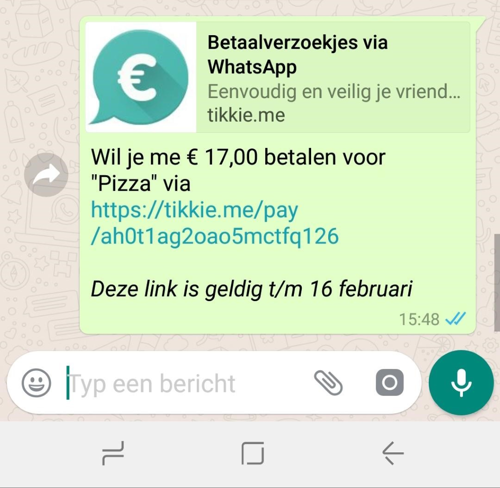
An example of Tikkie leveraging messaging tools like WhatsApp.
Datumprikker
Have you ever tried to schedule some quality time with your friends, family, or colleagues? Then you probably know how much of a hassle it can be to find the perfect time slot in everybody's overflowing agendas. That's precisely where scheduling tool Datumprikker comes in.
With a successful national version used to schedule 245.000 events each month, the international version of their platform was launched, Cally, in 2018. They tested their concept in over 20 countries by creating 'growth templates' to easily enroll with every launch.
With a true procedural and experimental attitude, they could grow their platform from 0 to 500.000 users in a very short time. Currently, Cally has grown to 2 million returning users. According to CEO Paul Bongers, "it was truly special to run this many experiments and see the impact on a weekly basis".
Key takeaway: Creating processes and procedures to enroll your service to another country can take away many initial issues and create room for exponential growth.
Fun fact: SEA was a key channel for the growth template. That scalable strategy eventually led to CPA's from 12 to 3 cents over different countries.
Ticketswap
Without any additional funding, Ticketswap has become a successful international company. The platform for reselling concert and festival tickets has grown towards 4 million users in over 40 countries.
They achieved this growth in a way that strikes some similarity with Airbnb: leveraging the users on another platform. In Ticketswap's case, that was Facebook. Moreover, they let users sell a ticket easily by sharing it on the Facebook event page.
Ticketswap also really knew what bothered people buying and selling tickets. The Facebook profiles gave an actual face to the seller, building trust with the buyer. The whole transaction process was automated, and therefore really easy for both the selling and buying parties.
Key takeaway: As Ticketswap has proven it, it's sometimes perfectly fine to grow your business on another platform's user base.
Fun fact: Before the whole Cambridge Analytics situation happened, Ticketswap had a team that analysed Facebook event data and reach out to people selling their tickets on event pages. This allowed to grow their business internationally quickly.
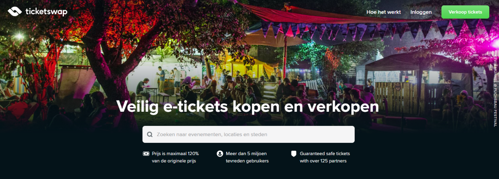
A screenshot of Ticketswap’s homepage.
BALR.
BALR. is a Dutch clothing brand founded by former Dutch football international Demy de Zeeuw - among others - in 2013. While the company may not directly correlate with term growth hacking, the way they grew their business is checking a lot of the boxes.
Influencer marketing is often perceived as a costly marketing channel. Well, BALR. has proven that it doesn't have to be the case since they never offered monetary compensation to their influencers. What they do offer is clothing. And in exchange, it is not even agreed upon that they have to do a post on it. Except for a few cases, the majority of the influencers will do a post anyways.
While many companies work with external agencies, BALR. has chosen to deal with influencer marketing in-house. This has the benefit that they can build genuine long-term relationships with the influencers. Many of the influencers - who range from professional sports players to the more traditional internet sensations - are believed to have become fans of BALR. This resulted in them wearing it more often. Therefore, the brand will be more intertwined with the influencer's personal brand and thus has become an authentic part of their life, which is a key part in the effectiveness of influencer marketing.
Key takeaway: By making influencers a true fan of your brand, you can create long-term relationships to generate sales and improve brand image.
Fun fact: BALR. first focussed on traditional celebrities in the football area. Asking players such as Neymar and Kevin de Bruyne to wear it before and after their games had a huge impact on BALR.’s brand awareness and brand image.

A few examples of typical BALR. Instagram posts.
Helloprint
When we tell you that Growth Hacking is all about data, we're not joking. HelloPrint is known for using Machine Learning and smart algorithms to product their customers' behaviors. Not only they mine their own database, but they also lookout for new trends, new interests, and even change in weather to predict demand in the market 18 months in advance.
That's not it, the Dutch company also invests in company DNA and ensure any new employee has a complete cultural fit. 'Teamwork makes the dream work' can only work if you have employees matching your company values and completing each other.
HelloPrint fills in the whole between individual customers and print producers. While print producers usually have a hard time selling to smaller customers for a reasonable price, it is due to a supply chain that isn't optimized for smaller orders. Smaller orders usually mean high costs, which implies cutting back a big chunk of their potential audience. HelloPrint creates a bridge between print producers and individual customers at better prices for both.
Key takeaway: Truth is, Machine Learning can probably mine, analyze and predict your future customer behavior much faster than a team could. Not especially better, but faster for sure.
Coolblue
In a highly competitive market Coolblue arose with a clear differentiation strategy. In contrast to its competitors, the Rotterdam based webshop does not focus on being the cheapest. And that strategy paid off. In 2019, their revenue rose towards the 1.5 billion mark, with a profit of 15 million.
But what does that differentiation strategy include? Let’s take a look at their tagline: “everything for a smile”. In other words, they do everything for retention and help you make the best possible decision there is. They for example do this by:
Having a limited product range, only offering the best products, making it easier to decide what to buy.
Offering everything a customer could need to decide to buy a product on-page.
They are very lenient in their returning procedure. Products that are returned are also sold for a reduced price.
Furthermore, Coolblue tops their differentiation off by having a very distinctive, humurous tone of voice. For example, the wordplays found on their packaging or delivery trucks have become a very clever asset of their branding.
Key takeaway: Coolblue was able to create a strategy that was so different than its competitors, they cut themselves a large piece of the cake in a highly competitive market.
Fun fact: They use data to determine what specific kind of features a product should have and use it to create unique products together with the suppliers. By doing this they allow themselves to have products that can’t be bought at their competitors.
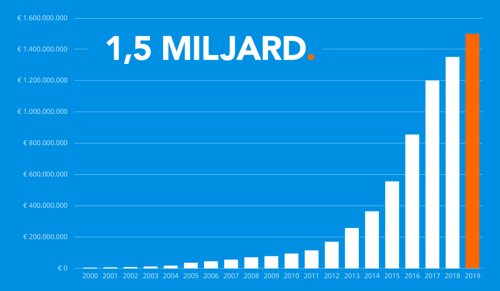
Coolblue’s revenue growth in the last 20 years.
Power Unlimited
When aiming for a young target audience, a business should always invest time exploring the best way to engage with the next generation.
This is exactly what Dutch video game news magazine & website, Power Unlimited, did at the beginning of 2020. They noticed the younger audiences all started using TikTok, and so they created unique videos on the platform. By providing their niche audience with the latest game news, tips, and unboxings daily, they have organically grown their TikTok account to over 100K followers and 3,5 million views a month. Thanks to their TikTok account, they landed multiple collaborations, such as Bol.com, MSI & Lenovo.
According to Chief Editor Martin Verschoor, there are a few key ingredients for anyone who wants to achieve a similar growth: "First you need to create content that is qualitative (good video content, optimized for mobile screens). Furthermore, you need to be current (post on what happend today, not last week) and make sure you posted regularly (preferably on a daily basis)."
Key takeaway: Always keep track of the latest trends within your target audience, and don't be afraid to test a new social media platform when it arises.
Fun fact: The explosive growth of their TikTok channel also impacted other channels. For example, Power Unlimited has seen an increase in website visitors and views on their YouTube videos.
Picnic
In 2019, Picnic was proclaimed to be the fastest growing company in The Netherlands. Because they only focus on delivering groceries, instead of offering it as an additional service like the traditional supermarkets, Picnic can keep innovating at an incredibly high pace, creating a beautiful example of end-to-end digital transformation.
The origin of Picnic’s success can be found in the fact they know what their target audience, people living in cities, truly want. And what do they want?
- They like small minimum order amounts and free delivery.
- They want to know they get their groceries for the cheapest price.
- They want to know when their groceries will be delivered as specific as possible.
They use these insights to optimize their algorithms and processes to make sure a customer can easily order groceries for a very concise time slot.
Key takeaway: By exactly knowing the pains of your customers and combining that with technological innovation you can create a service that can change enter a highly competitive market.
Fun fact: Because of its popularity, in a lot of cities Picnic had to deal with incredibly long waiting lists. To retain these customers, they offered them weekly wait softeners (which in Dutch is a wordplay for fabric softener) that they would receive for free at their first order.
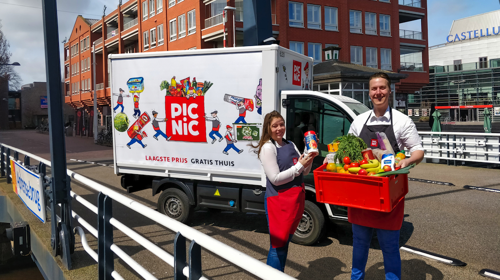
Picnic’s unique looking delivery carts & runners.
Swapfiets
Swapfiets didn't only revolutionize the bike industry; it also became the world's largest subscription-based service within a few years. The Delft based startup quickly attracted over 100,000 users and reached the spectacular growth of 500% per year.
So how did they reach a growth of 500% per year? They took care of all the pains bikers encounter, such as: flat tires, broken chains, stolen lights etc. They combined this with taking the pains away a lot of people have with subscription-based pricing models.
If you're Dutch, you've definitely had bike issues for sure. What did you do then? Repaired it yourself? Brought it to the repair shop? Left it on the side, thinking you'd fix it later and got a new one on Marktplaats? All of the above? This is what Swapfiets betted on. They offer a subscription model, including free repairs and a bike swap, if necessary, within a short time frame. Swapfiets developed a model that fixes any pain the customer may encounter.
They also offer student prices and a flexible model - allowing users to unsubscribe only one month in advance. The Dutch startup capitalized on the fact that users only get the product's advantages without its disadvantages. It seems like it did its work!
Key takeaway: Swapfiets proved that listening to your market is the key to delivering incredible growth. Leveraging your target audience’s pains will help you create a service/product perfectly fitted to the needs – and take a strong stance on a competitive market.
Funfact: Before offering bikes with their signature blue front tire, Swapfiets initially started by buying bikes from the city depot of retrieved bikes. Who knows, they may have bought one of your bikes?
